ASUSTeK Computer ME370T ASUS Pad User Manual
ASUSTeK Computer Inc ASUS Pad
User Manual

Eee Pad User Manual
ME370T
E7287
ASUS is devoted to creating environment-
friendly products/packagings to safeguard
consumers’ health while minimizing the
impact on the environment. The reduction
of the number of the manual pages complies
with the reduction of carbon emission.
For the detailed user manual and related
information, refer to the user manual
included in the device or visit the ASUS
Support Site at http://support.asus.com or
the Eee Pad website at http://eee.asus.com/
eeepad for updated information.

There are three main types of airport security devices:
X-ray machines (used on items placed on conveyor
belts), magnetic detectors (used on people walking
through security checks), and magnetic wands
(hand-held devices used on people or individual
items). You can send your Eee Pad through airport
X-ray machines. But do not send your Eee Pad
through airport magnetic detectors or expose it to
magnetic wands.
Charging Your Batteries
If you intend to use battery power, be sure to fully charge
your battery pack before going on long trips. Remember
that the power adapter charges the battery pack as long as
it is plugged into the computer and an AC power source. Be
aware that it takes much longer to charge the battery pack
when the Eee Pad is in use.
Remember to fully charge the battery (8 hours or more)
before rst use and whenever it is depleted to prolong
battery life. The battery reaches its maximum capacity after
a few full charging and discharging cycles.
Airplane Precautions
Ask an airline personnel if you want to use your Eee Pad
onboard an aircraft. Most airlines have restrictions for using
electronic devices. Most airlines allow electronic use only
between and not during takeos and landings.
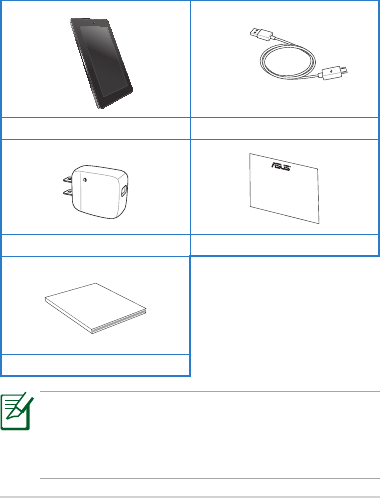
ASUS Eee Pad
3
Eee Pad Micro USB Cable
USB Charging Unit Warranty Card
User Manual
User Manual
Package contents
• Ifanyoftheitemsisdamagedormissing,contact
your retailer.
• Thebundledpowerplugvarieswithcountryor
region.
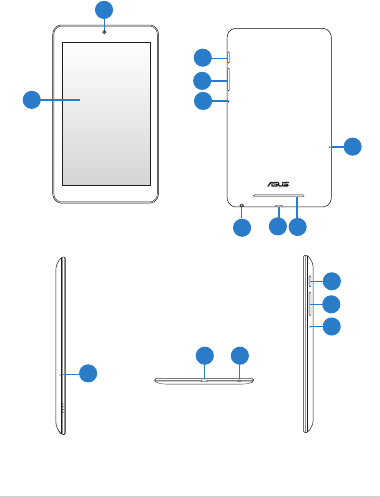
ASUS Eee Pad
4
Your Eee Pad
1
2
3
5
7
9
6
4
5
74
8
6
9
8
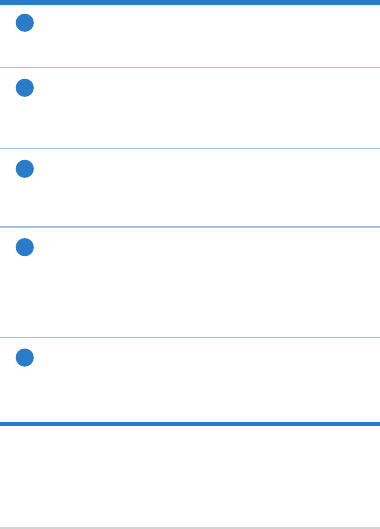
ASUS Eee Pad
5
1Touch screen panel
The touch screen panel allows you to operate your
Eee Pad using the stylus or touch gestures.
2Built-in front camera
Use the built-in camera for picture taking,
video recording, video conferencing, and other
interactive applications.
3Audio speaker system
Your Eee Pad is equipped with a built-in high
quality stereo speaker. Audio features are software
controlled.
4Audio jack
The stereo combo jack (3.5mm) connects the Eee
Pad’s audio out signal to amplied speakers or
headphones. Using this jack automatically disables
the built-in speaker.
5Built-in side microphone
The built-in mono microphone can be used for
video conferencing, voice narrations, or simple
audio recordings.
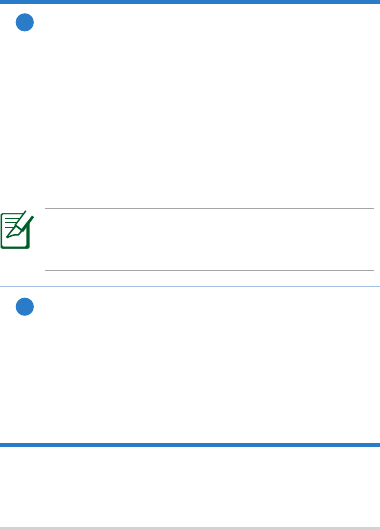
ASUS Eee Pad
6
6Power button
Press and hold the Power button for four seconds
to power on your Eee Pad.
When your Eee Pad is powered on, press the
Power button to put the Eee Pad into sleep mode
or wake it up from sleep mode.
If the system becomes unresponsive, press and
hold the power switch for at least eight seconds to
force the Eee Pad to shut down.
Press the Power button for four seconds and when
prompted, tap OK to shut down your Eee Pad.
Forcing the system to shut down may result in
data loss. Please ensure that you back up all your
important data regularly.
7Micro USB port (2.0)
The Micro USB (Universal Serial Bus) port allows
you to charge the battery of your Eee Pad using
the USB charger or transfer data from or to your
computer.
Charging via USB: If you connect your Eee Pad to
the USB port on your computer, your Eee Pad will
be charged only when it is in sleep mode (screen
off) or powered off.

ASUS Eee Pad
7
8Reset button
Using a paper clip, press this button to reset the
system to its factory default settings.
9Volume key
Press this button to increase or decrease the
system volume.
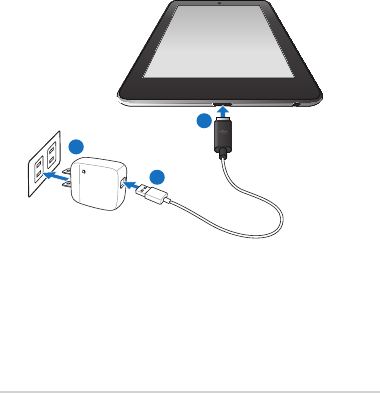
ASUS Eee Pad
8
Connecting to the power adapter
Connect the power adapter into the Eee Pad and to a power
outlet.
a
b
c
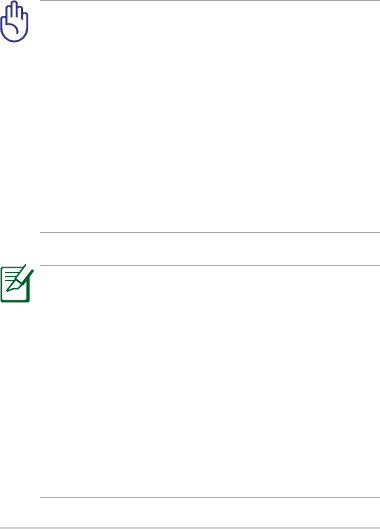
ASUS Eee Pad
9
• Useonlythepoweradapterthatcomeswith
your device. Using a dierent power adapter may
damage your device.
• Pleasepeeltheprotectivefilmofffromtheplug,
USB charging unit, and USB cable before charging
the Eee Pad to prevent risk or injury.
• UsingthebundledpoweradapterandUSBcableto
connect your Eee Pad to a power outlet is the best
way to charge the Eee Pad.
• Theinputvoltagerangebetweenthewalloutlet
and this adapter is AC 100V–240V, and the output
voltage of this adapter is DC 5V, 2A.
• Toprolongbatterylife,fullychargethebatteryfor
up to eight (8) hours when using the Eee Pad for
the rst time and whenever the battery power is
fully depleted.
• YourEeePadcanbechargedviatheUSBporton
the computer only when it is in sleep mode (screen
o) or powered o.
• ChargingthroughtheUSBportmaytakelonger
time to complete.
• Ifyourcomputerdoesnotprovideenoughpower
for charging your Eee Pad, charge your Eee Pad via
the power outlet instead.

ASUS Eee Pad
10
Setting up your Google account
Use your Google account to fully enjoy your Eee Pad's
Android features such as GTalk, Gmail, Navigation, Android
Market, and Maps.
If you have not set up your Google account the rst time
you turned on your Eee Pad, follow these steps to set up
your Google account:
1. From the upper right corner of the Home screen, tap
Apps.
2. Tap Settings > Accounts & sync > Add account.
3. Tap Google accounts.
4. Key in your e-mail address and password, then tap Sign
in. Wait for a few minutes until your Eee Pad connects to
the Google server.
If you do not have an existing Google account, create
one on the Google website at http://mail.google.
com
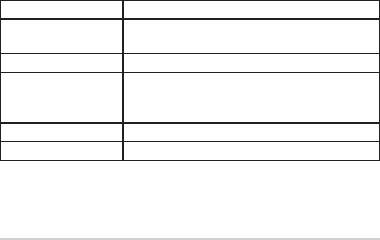
ASUS Eee Pad
11
Copyright Information
No part of this manual, including the products and software
described in it, may be reproduced, transmitted, transcribed,
stored in a retrieval system, or tranPadd into any language
in any form or by any means, except documentation kept
by the purchaser for backup purposes, without the express
written permission of ASUSTeK COMPUTER INC. (“ASUS”).
ASUS and Eee Pad logo are trademarks of ASUSTek
Computer Inc.
Information in this document is subject to change without
notice.
Copyright © 2012 ASUSTeK COMPUTER INC. All Rights
Reserved.
Manufacturer ASUSTek COMPUTER INC.
Address, City No. 150, LI-TE RD., PEITOU,
TAIPEI 112, TAIWAN R.O.C
Country TAIWAN
Authorized
Representative
in Europe
ASUS COMPUTER GmbH
Address, City HARKORT STR. 21-23, 40880 RATINGEN
Country GERMANY

ASUS Eee Pad
12
Limitation of Liability
Circumstances may arise where because of a default on
ASUS’ part or other liability, you are entitled to recover
damages from ASUS. In each such instance, regardless of
the basis on which you are entitled to claim damages from
ASUS, ASUS is liable for no more than damages for bodily
injury (including death) and damage to real property and
tangible personal property; or any other actual and direct
damages resulted from omission or failure of performing
legal duties under this Warranty Statement, up to the listed
contract price of each product.
ASUS will only be responsible for or indemnify you for loss,
damages or claims based in contract, tort or infringement
under this Warranty Statement.
This limit also applies to ASUS’ suppliers and its reseller. It is
the maximum for which ASUS, its suppliers, and your reseller
are collectively responsible.
UNDER NO CIRCUMSTANCES IS ASUS LIABLE FOR ANY OF
THE FOLLOWING: (1) THIRD-PARTY CLAIMS AGAINST YOU
FOR DAMAGES; (2) LOSS OF, OR DAMAGE TO, YOUR RECORDS
OR DATA; OR (3) SPECIAL, INCIDENTAL, OR INDIRECT
DAMAGES OR FOR ANY ECONOMIC CONSEQUENTIAL
DAMAGES (INCLUDING LOST PROFITS OR SAVINGS), EVEN IF
ASUS, ITS SUPPLIERS OR YOUR RESELLER IS INFORMED OF
THEIR POSSIBILITY.
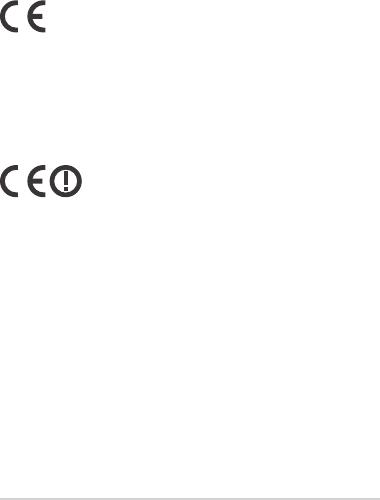
ASUS Eee Pad
13
CE Mark Warning
CE marking for devices without wireless LAN/
Bluetooth
The shipped version of this device complies with
the requirements of the EEC directives 2004/108/EC
“Electromagnetic compatibility” and 2006/95/EC “Low
voltage directive”.
CE marking for devices with wireless LAN/
Bluetooth
This equipment complies with the requirements of
Directive 1999/5/EC of the European Parliament and
Commission from 9 March, 1999 governing Radio and
Telecommunications Equipment and mutual recognition of
conformity.
Power Safety Requirement
Products with electrical current ratings up to 6A and
weighing more than 3Kg must use approved power cords
greater than or equal to: H05VV-F, 3G, 0.75mm2 or H05VV-F,
2G, 0.75mm2.
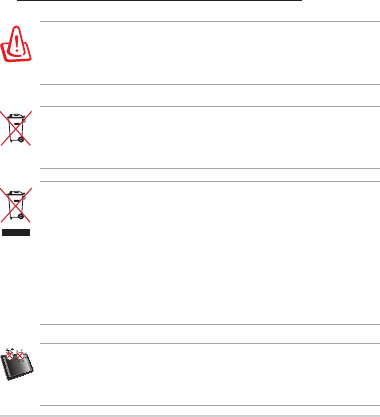
ASUS Eee Pad
14
ASUS Recycling/Takeback Services
ASUS recycling and takeback programs come from our
commitment to the highest standards for protecting our
environment. We believe in providing solutions for you to
be able to responsibly recycle our products, batteries, other
components as well as the packaging materials. Please go
to http://csr.asus.com/english/Takeback.htm for detailed
recycling information in different regions.
DO NOT throw the battery in municipal waste. The
symbol of the crossed out wheeled bin indicates that
the battery should not be placed in municipal waste.
Risk of explosion if battery is replaced by an incorrect
type. Dispose of used batteries according to the
instructions.
DO NOT throw the Eee Pad in municipal waste. This
product has been designed to enable proper reuse
of parts and recycling. The symbol of the crossed out
wheeled bin indicates that the product (electrical,
electronic equipment and mercury-containing
button cell battery) should not be placed in
municipal waste. Check local regulations for disposal
of electronic products.
SAFE TEMP: This Eee Pad should only be used in
environments with ambient temperatures between 0
°C (32°F) and 35°C (95°F).

ASUS Eee Pad
15
Declarations and Safety Statements
Federal Communications Commission Statement
This device complies with part 15 of the FCC Rules. Operation
is subject to the following two conditions: (1) This device may
not cause harmful interference, and (2) this device must accept
any interference received, including interference that may cause
undesired operation.
This device has been tested and found to comply with the limits
for a Class B digital device, pursuant to Part 15 of the FCC Rules.
These limits are designed to provide reasonable protection against
harmful interference in a residential installation. This equipment
generates, uses and can radiate radio frequency energy and, if not
installed and used in accordance with the instructions, may cause
harmful interference to radio communications. However, there is no
guarantee that interference will not occur in a particular installation
If this equipment does cause harmful interference to radio or
television reception, which can be determined by turning the
equipment off and on, the user is encouraged to try to correct the
interference by one or more of the following measures:
•Reorientorrelocatethereceivingantenna.
•Increasetheseparationbetweentheequipmentandreceiver.
•Connecttheequipmentintoanoutletonacircuitdifferentfrom
that to which the receiver is connected.
•Consultthedealeroranexperiencedradio/TVtechnicianforhelp.
Changes or modifications not expressly approved by the party
responsible for compliance could void the user‘s authority to
operate the equipment.

ASUS Eee Pad
16
The antenna(s) used for this transmitter must not be co-located or
operating in conjunction with any other antenna or transmitter.
RF Exposure Information (SAR)
This device meets the government’s requirements for exposure
to radio waves. This device is designed and manufactured not to
exceed the emission limits for exposure to radio frequency (RF)
energy set by the Federal Communications Commission of the U.S.
Government.
The exposure standard employs a unit of measurement known as
the Specific Absorption Rate, or SAR. The SAR limit set by the FCC
is 1.6W/kg. Tests for SAR are conducted using standard operating
positions accepted by the FCC with the EUT transmitting at the
specified power level in different channels. The highest SAR value
for the device as reported to the FCC is 1.17 W/kg when placed next
to the body.
The FCC has granted an Equipment Authorization for this device
with all reported SAR levels evaluated as in compliance with the FCC
RF exposure guidelines. SAR information on this device is on file with
the FCC and can be found under the Display Grant section of www.
fcc.gov/oet/ea/fccid after searching on FCC ID: MSQME370T.

ASUS Eee Pad
17
This device is in compliance with SAR for general population /
uncontrolled exposure limits in ANSI/IEEE C95.1-1999 and had
been tested in accordance with the measurement methods and
procedures specified in OET Bulletin 65 Supplement C.
IC Regulations
This device complies with Industry Canada licence-exempt RSS
standard(s). Operation is subject to the following two conditions:
(1) this device may not cause interference, and (2) this device must
accept any interference, including interference that may cause
undesired operation of the device.
This Class B digital apparatus complies with Canadian ICES-003.
Cet appareil numérique de la classe B est conforme à la norme NMB-
003 du Canada.
This Category II radiocommunication device complies with Industry
Canada Standard RSS-310.
Ce dispositif de radiocommunication de catégorie II respecte la
norme CNR-310 d’Industrie Canada.
IC Radiation Exposure Statement
This EUT is in compliance with SAR for general population/
uncontrolled exposure limits in IC RSS-102 and had been tested
in accordance with the measurement methods and procedures
specified in IEEE 1528. This equipment should be installed and
operated with minimum distance 0cm between the radiator & your
body.
This device and its antenna(s) must not be co-located or operating in
conjunction with any other antenna or transmitter.

ASUS Eee Pad
18
The County Code Selection feature is disabled for products
marketed in the US/Canada.
For product available in the USA/ Canada markets, only channel
1~11 can be operated. Selection of other channels is not possible.